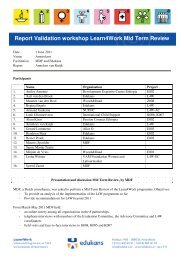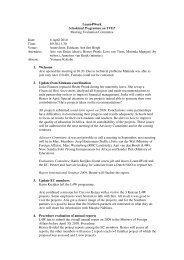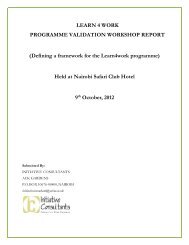DRAFT TECHNICAL AND VOCATIONAL EDUCATION AND ...
DRAFT TECHNICAL AND VOCATIONAL EDUCATION AND ...
DRAFT TECHNICAL AND VOCATIONAL EDUCATION AND ...
Create successful ePaper yourself
Turn your PDF publications into a flip-book with our unique Google optimized e-Paper software.
11<br />
than 25% of Ghana’s youth reach proficiency levels for P6 English, and 10% attain<br />
proficiency in P6 mathematics (MoESS, 2008, p. 16).<br />
From the demand side, the quantity is overwhelming while the input quality is low. The basic<br />
academic skills (literacy and numeracy) are the foundation for successful skill learning, and<br />
deficits brought from the primary school through JHS to post-basic TVET create serious<br />
problems for skill acquisition and the learning of related theory.<br />
The supply side of the TVET sector consists of informal apprenticeship providers (individual<br />
master craftsmen and women and the various trade and professional associations), and formal<br />
public and private TVET training institutions. The informal aspect of the supply side (the<br />
informal apprenticeship system is larger but has not been captured through systematic<br />
documentation. The private ones may be for-profit or not-for-profit. As the private providers<br />
register with different government ministries and bodies, their actual numbers are not certain.<br />
Table 2.5 shows the main providers that constitute the supply side of formal TVET in Ghana,<br />
as reported in the Education Sector Performance Report (MoESS, 2008). The figures for<br />
private TVET do not reflect the true picture. Out of 700 questionnaires sent out by the<br />
Education Management Information System (EMIS), only 273 (130 public and 143 private)<br />
responded, meaning “there is much information that is not currently being captured” (MoESS,<br />
2008, p. 131) especially on private TVET in the country. Also, the NVTI reported having<br />
337 registered private vocational training institutes and 160 public ones (Personal<br />
Communication, 27/11/08). There could be overlaps between the survey results obtained by<br />
the EMIS and the registrations undertaken by the NVTI.<br />
In general, the supply side of the TVET sector is weak due to decades of neglect and lack of<br />
government support (UNESCO, 2003; Report of the President’s Committee on Review of<br />
Education Reforms in Ghana, 2002). The weaknesses are numerous but the major ones are:<br />
inadequate capacity of existing institutions; inadequate supply of consumable materials used<br />
in training, obsolete training equipment; poor infrastructure; teaching staff who lack practical<br />
skills and work experience; outdated textbooks and curricula; and weak links with industry.<br />
The Education Sector Performance Report 2008 (MoESS, 2008) concluded that<br />
“Infrastructure in TVET institutions continues to be poor with only 80% having functional<br />
electricity.” In short, the supply side of the TVET sector is not able to cope with the demand<br />
for skill training from learners and also produce the quality that industry needs – because of<br />
infrastructural and resource constraints.<br />
Table 2.5: Formal and Public (Non-tertiary) TVET Institutions, 2007/2008<br />
Ownership/Location<br />
Ministry of Education,<br />
Science and Sports<br />
Ministry of Manpower,<br />
Youth and Employment<br />
Ministry of Food and<br />
Agriculture (MoFA)<br />
Type of Institution<br />
Number<br />
2006/2007 2007/2008<br />
GES Technical institutes 24 25<br />
NVTI Centres 28 21<br />
Integrated Community Centres for<br />
31 35<br />
Employable Skills (ICCES)<br />
Social Welfare Centres 11 13<br />
Leadership Training Institutes 7 9<br />
Opportunities Industrialisation<br />
Centre (OIC)<br />
1 1<br />
Community Development Centres 22 22<br />
Agriculture Training Institutes (Farm<br />
1 1<br />
Institutes)







